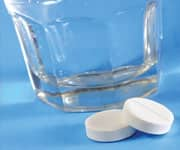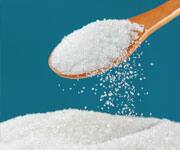Life Extension Magazine®
Low-Dose Aspirin Reduces Risk Of Dying Among Heart Failure Patients By 42% | |
In an article published recently in the journal Circulation: Heart Failure, researchers from Ireland report a survival benefit for low-dose aspirin among heart failure patients.* The study evaluated 1,476 men and women enrolled in a heart failure disease management program. Aspirin was prescribed to 892 subjects, among whom 828 were recommended a low dose of 75 milligrams per day. Over a follow-up period of up to twelve years (median of 2.6 years), 464 deaths occurred. Subjects who used low dose aspirin had a 42% lower adjusted risk of dying over follow-up and 30% lower risk of being hospitalized for heart failure in comparison with non-aspirin users. Those who used high-dose aspirin experienced a risk of dying similar to those who did not use the drug. Editor’s Note: Authors Margaret Bermingham and her colleagues observe that in recent trials that identified a greater risk of cardiovascular and heart failure events in aspirin users in comparison with those who used the anticoagulant drug warfarin, the dose of aspirin ranged from 162 to 335 milligrams per day, which is much higher than the low dose commonly used in Europe. They remark that the current findings “challenge the belief that aspirin should be avoided in secondary prevention patients who go on to develop heart failure” and go on to suggest that patients on higher antiplatelet doses of aspirin may benefit from aspirin dose reduction. —D. Dye |
|
| Reference | |
* Circ Heart Fail . 2014 Feb 3. |
|
Dietary Supplements Part Of A Healthy Lifestyle | |
A review published in Nutrition Journal concludes that, rather than compensating for poor eating habits and a lack of exercise, the use of nutritional supplements is part of an overall healthy lifestyle among the majority of those who use them.* “Compiling the available data on the health habits of dietary supplement users, we gained a sharper insight into the positive lifestyle choices of this large segment—one half to two-thirds—of the American population that takes supplements,” remarked coauthor Annette Dickinson, PhD. “Evidence from numerous surveys shows that dietary supplement users are more likely than non-users to adopt a number of positive health-related habits such as consuming healthier diets, exercising regularly, maintaining a healthy body weight, and avoiding tobacco products.” “Dietary supplement users typically make healthful habits part of each day, and many stick with their supplement regimen for years,” added coauthor Douglas McKay, ND. Editor’s Note: Drs. Dickinson and McKay found that reliance upon food alone to receive one’s nutrients resulted in intake levels below the Estimated Average Requirement for many nutrients. This status was improved by 50% by the consumption of enriched and fortified foods, and was further improved by supplementation. —D. Dye |
|
| Reference | |
* Nutr J. 2014 Feb 6;13(1):14. |
|
Meta-Analysis Affirms Association Between Omega-3 Fatty Acid Supplementation And Lower Markers Of Inflammation | |
The results of a meta-analysis published in PLoS One contribute further evidence of an anti-inflammatory benefit for supplementation with marine-derived omega-3 fatty acids EPA and DHA.* Researchers selected 68 randomized trials that examined the effects of omega-3 fatty acids in a total of 4,601 participants. The trials involved subjects with chronic autoimmune disease, chronic non-autoimmune disease, or healthy participants. A pooled analysis of all subjects confirmed a significant association between omega-3 fatty acid supplementation and decreased blood levels of C-reactive protein (CRP) and interleukin-6 (IL-6), which are markers of inflammation. Among those with chronic non-autoimmune disease, a greater reduction in blood levels of IL-6 and tumor necrosis factor-alpha (another marker of inflammation) was observed in association with a longer duration of supplementation. A similar relationship was observed for IL-6 among healthy participants. Editor’s Note: When studies that utilized fish as a source of omega-3 fatty acids were separately analyzed, an association was found for a decrease in interleukin-6 with increased intake, but unlike fish oil supplements, fish alone did not decrease CRP or tumor necrosis factor. —D. Dye |
|
| Reference | |
* PLoS One. 2014 Feb 5;9(2):e88103. |
|
Higher Vitamin C Levels Linked To Lower Risk Of Hemorrhagic Stroke | |
A presentation at the American Academy of Neurology’s 66th Annual Meeting revealed a protective effect for high plasma levels of vitamin C against the risk of hemorrhagic stroke.* “Scurvy is caused by vitamin C deficiency, specifically a plasma vitamin C concentration of less than 11 micromoles per liter, and may have hemorrhagic manifestations,” write authors Stéphane Vannier, MD, and colleagues. “Vitamin C depletion (less than 38 micromoles per liter) is associated with cardiovascular diseases and could increase intracerebral hemorrhage risk.” The researchers compared plasma ascorbate levels of 65 acute intracerebral hemorrhage patients with an equal number of control subjects. Subjects with stroke had depleted vitamin C levels averaging 35.3 micromoles per liter, in comparison with the control group, whose levels were normal at an average of 56.2 micromoles per liter. Depleted levels of vitamin C were also associated with longer hospitalization. Editor’s Note: Hemorrhagic stroke is characterized by bleeding in the brain and, although less common than ischemic stroke, is associated with a greater risk of mortality. —D. Dye | |
| Reference | |
* American Academy of Neurology 66th Annual Meeting, Philadelphia, April 26-May 3, 2014. | |
Creatine Shows Promise In Huntington Disease | |
A trial conducted at Massachusetts General Hospital has uncovered a benefit for creatine in delaying the symptoms of the inherited neurodegenerative disorder known as Huntington disease in asymptomatic adults.* The trial included 109 men and women with a family history of Huntington disease, some of whom were aware of carrying a mutated form of the gene that causes the disease. For the double-blinded portion of the trial, half of the participants received a placebo and the remainder received 30 grams creatine per day for six months. This was followed by a 12 month open-label period in which some of the participants who received a placebo were switched to creatine. At the end of the placebo-controlled phase of the trial, the rate of atrophy in the brain’s cortex and striatum among pre-manifest Huntington disease carriers was slower among those who received creatine than among the placebo group, who experienced progression. Editor’s Note: This benefit was also observed among presymptomatic subjects who began creatine supplementation after the placebo-controlled phase. —D. Dye | |
| Reference | |
* Neurology. 2014 Feb 7. | |
Better Think Twice Before Adding That Spoonful Of Sugar | |
The conclusion of a study described recently in JAMA Internal Medicine suggests that adding sugar to the diet could significantly increase the risk of dying from cardiovascular disease, the leading cause of death in the developed world.* Researchers at the CDC evaluated data from participants in the National Health and Nutrition Examination Surveys (NHANES) of the US population. While 71.4% of adults consumed at least 10% or more of their calories from added sugar during 2005-2010, sugar counted for at least 25% of the calories among 10% of the group. When the researchers examined the association between added sugar and the risk of cardiovascular death over a median 14.6 years of follow-up, subjects whose intake was among the top one-fifth of participants had an adjusted risk that was twice that of participants whose intake was among the lowest fifth. Editor’s Note: An intake of sugar that accounted for 25% or more of one’s calories was associated with a 2.75 times greater risk of cardiovascular disease mortality in comparison with an intake of less than 10%. —D. Dye | |
| Reference | |
* JAMA Int Med. 2014 Feb 3. | |
Primate Brains Show Omega-3 Benefit | |
In the Journal of Neuroscience, Oregon Health and Science University researchers report a brain benefit for the omega-3 fatty acid docosahexaenoic acid (DHA) in rhesus macaques.* The study is the first to utilize functional brain magnetic resonance imaging (FMRI) to observe the interaction of multiple brain networks in live monkeys. The research involved rhesus macaques between the ages of 17 and 19 who had been given life-long diets that were low or high in DHA. Damien Fair, PA-C, PhD, and his colleagues found stronger connectivity of early visual pathways in the brains of monkeys given high-DHA diets as well as increased connections within brain networks similar to those found in humans, including those related to cognition and higher-level processing. “The data shows the benefits in how the monkeys’ brains organize over their lifetime if in the setting of a diet high in omega-3 fatty acids,” Dr. Fair concluded. Editor’s Note: Dr. Fair added that, “The data also shows in detail how similar the networks in a monkey brain are to networks in a human brain, but only in the context of a diet rich in omega-3-fatty acids.” —D. Dye | |
| Reference | |
* J Neurosci. 2014 Feb 5. | |
Young US Workers Benefit From Mediterranean Diet | |
An article published in the journal PLoS One reveals a protective effect for a Mediterranean diet, characterized by an abundance of fruit, vegetables, whole grain, nuts, fish, and olive oil, against the risk of cardiovascular disease in Midwestern firefighters.* Lifestyle questionnaire responses of 780 male firefighters were scored on their adherence to a Mediterranean-style diet. Subjects whose adherence to the diet was greatest had a 35% lower risk of metabolic syndrome in comparison with men whose adherence was lowest. The group with the greatest adherence also had a 43% lower risk of weight gain over the previous five years, lower body fat percentage, greater high-density lipoprotein (HDL) cholesterol levels and lower low-density lipoprotein (LDL) cholesterol. “Our study adds more evidence showing the health benefits of a Mediterranean diet, even after adjusting for exercise and body weight,” commented study coauthor Stefanos Kales. Editor’s Note: Metabolic syndrome is a disorder characterized by a cluster of risk factors, including abdominal obesity, disordered lipids, hypertension, and elevated blood glucose, which significantly increases the risk of developing diabetes or cardiovascular disease. —D. Dye | |
| Reference | |
* PLoS One. 2014 Feb 2. | |
Meta-analysis Associates Omega-3 Fatty Acid Supplementation With Lower Risk Of Death From All Causes Over Follow-up | |
The results of a meta-analysis published in the journal Nutrition, Metabolism, and Cardiovascular Diseases reveal a reduction in the risk of dying from cardiac or any other cause among coronary heart disease patients supplemented with omega-3 fatty acids in trials ranging from less than three months to 4.6 years.* Researchers at Nanjing University selected fourteen clinical trials involving a total of 16,318 participants randomized to receive a placebo and 16,338 subjects given the omega-3 fatty acids EPA and/or DHA that evaluated the supplements’ effects on cardiovascular events, cardiac death, sudden cardiac death, or death from any cause. Those who received the fatty acids had a 12% lower average risk of dying from cardiac causes, a 14% lower risk of sudden cardiac death and an 8% lower risk of death from any cause over follow-up in comparison with subjects who received a placebo. Editor’s Note: A separate analysis limited to those diagnosed with coronary atherosclerosis (before any occurrence of heart attack or heart failure) uncovered a 51% reduction in the risk of major cardiovascular events in association with omega-3 supplementation compared to placebo. —D. Dye | |
| Reference | |
* Nutr Metab Cardiovasc Dis . 2013 Dec 25 |
|
Cinnamon Improves Liver Enzymes And Other Factors In Nonalcoholic Fatty Liver Disease | |
Cinnamon Improves Liver Enzymes And Other Factors In Nonalcoholic Fatty Liver Disease A recent issue of the journal Nutrition Research described the outcome of a trial conducted by Iranian researchers which revealed a benefit for cinnamon in men and women with nonalcoholic fatty liver disease (NAFLD).* The trial included fifty men and women between the ages of 20 and 65 years with NAFLD. Participants were randomized to receive two 750 milligram capsules of cinnamon or a placebo daily for twelve weeks. Blood samples collected before and after the treatment period were analyzed for fasting blood glucose, lipids, liver enzymes, and C-reactive protein, a marker of inflammation. Among those who received cinnamon, a significant reduction in glucose, total cholesterol, insulin resistance, triglycerides, C-reactive protein, and liver enzymes occurred, while remaining relatively unchanged among those who received a placebo. Editor’s Note: Nonalcoholic fatty liver disease includes steatosis, nonalcoholic steatohepatitis (NASH), fibrosis, cirrhosis, and hepatocellular carcinoma, and can result in death if left untreated. —D. Dye | |
| Reference | |
|
* Nutr Res. 2014 Feb;34(2):143-8. | |
Too Much Sitting Linked To Major Disability For Those Over Age 60 | |
A team of researchers from Northwestern University’s Center for Healthcare Studies became the first group to identify sedentary behavior as an independent risk factor for disability in performing activities of daily life (ADL) such as eating, getting in and out of bed, and bathing.* “This is the first time we’ve shown sedentary behavior was related to increased disability regardless of the amount of moderate exercise,” said Dorothy Dunlop, lead author of the study. Study participants included 2,286 adults aged 60 and older from the National Health and Nutrition Examination Survey. Participants wore an accelerometer (a device that measures physical activity) for at least four days and underwent a physical exam. Participants spent almost 9 hours a day being sedentary during waking hours and 3.6% reported ADL disability. The odds of ADL disability were 46% greater for each daily hour spent in sedentary behavior even after being adjusted for moderate-vigorous activity, socioeconomic status, and other health factors. This study revealed a strong relationship between increased sedentary behavior and the presence of ADL disability, independent of moderate or vigorous activity. Editor’s Note: To cut down on sitting time, the study authors suggest standing up when you talk on the phone and standing up during meetings. They also suggest parking in a space far away from the grocery store or mall, and when you get up to have a glass of water, they say you should take a walk around the house or office. Also, they suggest people take the stairs instead of an elevator whenever possible. —A. Pryce | |
| Reference | |
* J Phys Act Health. 2014 Feb 5. |












